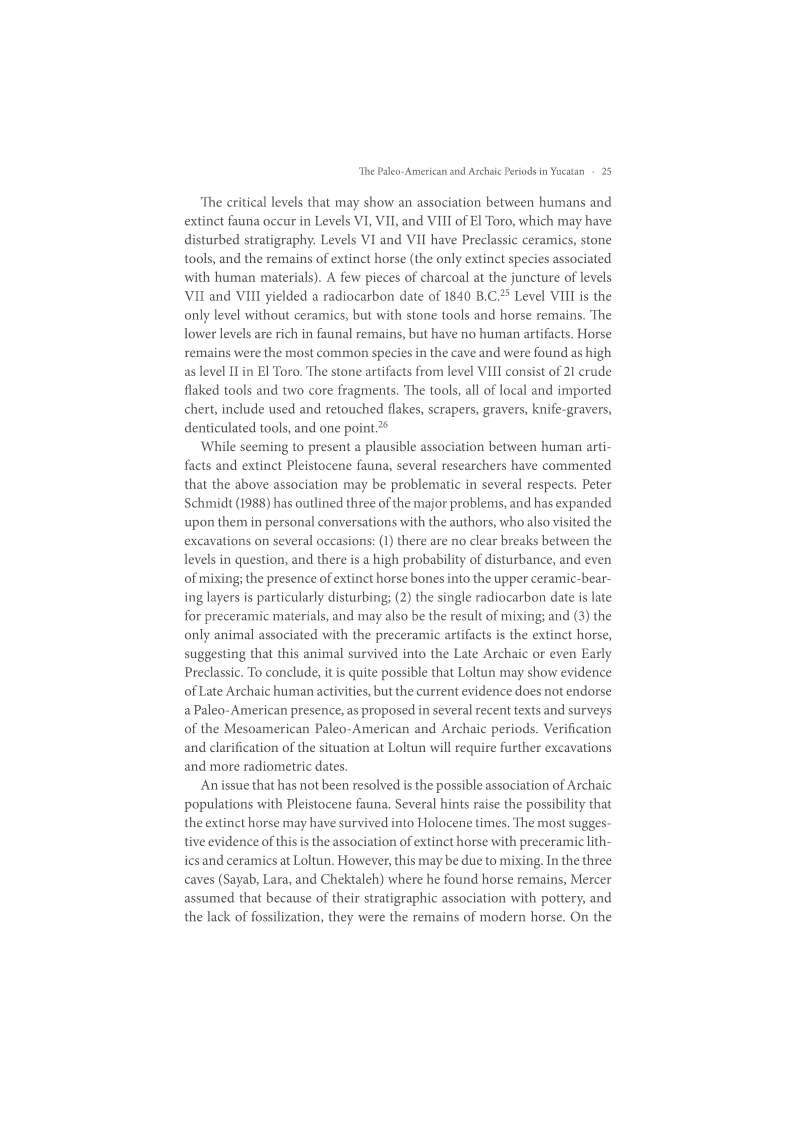Anthony P. Andrews and Fernando Robles Castellanos on Horses Surviving into Post-Pleistocene Times in Mesoamerica.
- Type
- Book
- Source
- Anthony P. Andrews Non-LDS
- Hearsay
- Secondary
- Reference
Anthony P. Andrews and Fernando Robles Castellanos, "The Paleo-American and Archaic Periods in Yucatan," in M. Kathryn Brown and George J. Bey III, eds., Pathways to Complexity: A View of the Maya Lowlands (Gainesville, Fla.: University Press of Florida, 2018), 25-26
- Scribe/Publisher
- University of Florida Press
- People
- Anthony P. Andrews, Fernando Robles Castellanos
- Audience
- Reading Public
- Transcription
The critical levels that may show an association between humans and extinct fauna occur in Levels VI, VII, and VIII of El Toro, which may have disturbed stratigraphy. Levels VI and VII have Preclassic ceramics, stone tools, and the remains of extinct horse (the only extinct species associated with human materials). A few pieces of charcoal at the juncture of levels VII and VIII yielded a radiocarbon date of 1840 B.C.[ The original date reported by Velásquez (1805 B.C. ± 150; 1980:54) is erroneous. The actual date, uncalibrated, is 3790± 105 B.P., or 1840 ± 105 B.C. Calibrated 1-sigma ranges are: 2434–2421 B.C.; 2403–2379 B.C.; 2349–2123 B.C.; 2093–2042 B.C. Calibrated 2-sigma ranges are: 2549–2538 B.C.; 2490–1936 B.C. (Andrews V 1990:19, note 14).] Level VIII is the only level without ceramics, but with stone tools and horse remains. The lower levels are rich in faunal remains, but have no human artifacts. Horse remains were the most common species in the cave and were found as high as level II in El Toro. The stone artifacts from level VIII consist of 21 crude flaked tools and two core fragments. The tools, all of local and imported chert, include used and retouched flakes, scrapers, gravers, knife-gravers, denticulated tools, and one point.[Preliminary reports on the excavations at Loltun Cave were published by Velásquez (1980, 1981). The analysis of the materials was carried out by Ernesto González Licón (1986). Most of the artifacts and ecofacts have been analyzed and reported, including the lithics (Konieczna 1981), mammalian fauna (Alvarez 1983), molluscs (Polaco 1983), and pollen (Xelhuantzi-López 1986). The faunal analysis conducted by Alvarez is the most extensive ever published on early Yucatecan paleontology. Schmidt (1988) has written an extensive summary of the Loltun excavations, along with a cogent critical discussion of the problems involved with the interpretations of the finds.]
While seeming to present a plausible association between human artifacts and extinct Pleistocene fauna, several researchers have commented that the above association may be problematic in several respects. Peter Schmidt (1988) has outlined three of the major problems, and has expanded upon them in personal conversations with the authors, who also visited the excavations on several occasions: (1) there are no clear breaks between the levels in question, and there is a high probability of disturbance, and even of mixing; the presence of extinct horse bones into the upper ceramic-bearing layers is particularly disturbing; (2) the single radiocarbon date is late for preceramic materials, and may also be the result of mixing; and (3) the only animal associated with the preceramic artifacts is the extinct horse, suggesting that this animal survived into the Late Archaic or even Early Preclassic. To conclude, it is quite possible that Loltun may show evidence of Late Archaic human activities, but the current evidence does not endorse a Paleo-American presence, as proposed in several recent texts and surveys of the Mesoamerican Paleo-American and Archaic periods. Verification and clarification of the situation at Loltun will require further excavations and more radiometric dates.
An issue that has not been resolved is the possible association of Archaic populations with Pleistocene fauna. Several hints raise the possibility that the extinct horse may have survived into Holocene times. The most suggestive evidence of this is the association of extinct horse with preceramic lithics and ceramics at Loltun. However, this may be due to mixing. In the three caves (Sayab, Lara, and Chektaleh) where he found horse remains, Mercer assumed that because of their stratigraphic association with pottery, and the lack of fossilization, they were the remains of modern horse. On the other hand, E. D. Cope, a paleontologist who commented on the remains, raised the possibility that they might belong to an extinct species, Equus occidentalis (Mercer 1896:172n). Hatt’s horse remains were from Actun Lara, one of the caves where Mercer had also uncovered horse remains. These were partially fossilized, and have been identified as extinct horse—either E. conversidens or E. tau, which may be the same species. These were also associated with pottery, and two foot bones were associated with the bones of modern cattle (Hatt et al. 1953: 71–72; see also Ray 1957). Once again, this may have been a disturbed deposit. Contrary to widely held views, at least two species of large mammals thought to have become extinct at the end of the Pleistocene survived into the Holocene in the Old World (Stuart et al. 2004). Since the horse also survived into post-Pleistocene times in the Old World, the possibility of its survival into Archaic times in the American tropics may also need to be considered.
- Citations in Mormonr Qnas
The B. H. Roberts Foundation is not owned by, operated by, or affiliated with the Church of Jesus Christ of Latter-day Saints.

